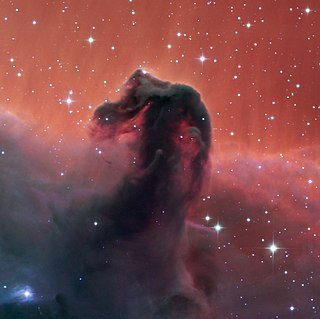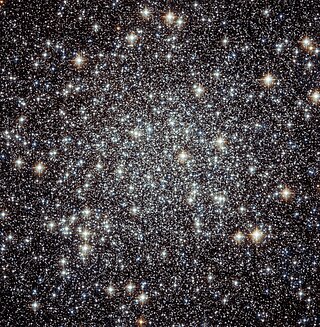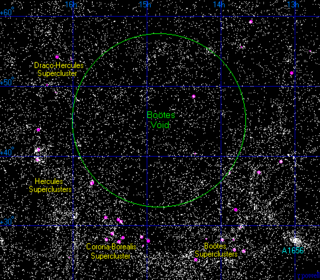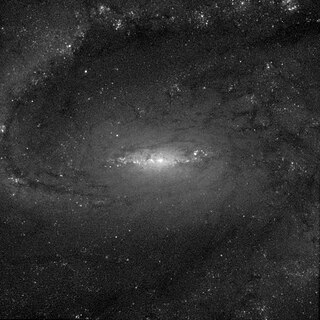
Sagittarius is one of the constellations of the zodiac and is located in the Southern celestial hemisphere. It is one of the 48 constellations listed by the 2nd-century astronomer Ptolemy and remains one of the 88 modern constellations. Its old astronomical symbol is (♐︎). Its name is Latin for "archer". Sagittarius is commonly represented as a centaur drawing a bow. It lies between Scorpius and Ophiuchus to the west and Capricornus and Microscopium to the east.
Timeline of stellar astronomy

Monoceros is a faint constellation on the celestial equator. Its definition is attributed to the 17th-century cartographer Petrus Plancius. It is bordered by Orion to the west, Gemini to the north, Canis Major to the south, and Hydra to the east. Other bordering constellations include Canis Minor, Lepus, and Puppis.

Edward Emerson Barnard was an American astronomer. He was commonly known as E. E. Barnard, and was recognized as a gifted observational astronomer. He is best known for his discovery of the high proper motion of Barnard's Star in 1916, which is named in his honor.

The Horsehead Nebula is a small dark nebula in the constellation Orion. The nebula is located just to the south of Alnitak, the easternmost star of Orion's Belt, and is part of the much larger Orion molecular cloud complex. It appears within the southern region of the dense dust cloud known as Lynds 1630, along the edge of the much larger, active star-forming H II region called IC 434.

NGC 281, IC 11 or Sh2-184 is a bright emission nebula and part of an H II region in the northern constellation of Cassiopeia and is part of the Milky Way's Perseus Spiral Arm. This 20×30 arcmin sized nebulosity is also associated with open cluster IC 1590, several Bok globules and the multiple star, B 1. It collectively forms Sh2-184, spanning over a larger area of 40 arcmin. A recent distance from radio parallaxes of water masers at 22 GHz made during 2014 is estimated it lies 2.82±0.20 kpc. from us. Colloquially, NGC 281 is also known as the Pacman Nebula for its resemblance to the video game character.

Messier 22 or M22, also known as NGC 6656 or the Great Sagittarius Cluster, is an elliptical globular cluster of stars in the constellation Sagittarius, near the Galactic bulge region. It is one of the brightest globulars visible in the night sky. The brightest stars are 11th magnitude, with hundreds of stars bright enough to resolve with an 8" telescope. It is just south of the sun's position in mid-December, and northwest of Lambda Sagittarii, the northernmost star of the "Teapot" asterism.

The Small Sagittarius Star Cloud is a star cloud in the constellation of Sagittarius approximately 600 light years wide, which was catalogued by Charles Messier in 1764. It should not be confused with the nearby Large Sagittarius Star Cloud which lies about 10° to the south.

The Merope Nebula is a diffuse reflection nebula in the Pleiades star cluster, surrounding the 4th magnitude star Merope. It was discovered on October 19, 1859 by the German astronomer Wilhelm Tempel. The discovery was made using a 10.5 cm refractor. John Herschel included it as 768 in his General Catalogue of Nebulae and Clusters of Stars but never observed it himself.

Barnard's Loop is an emission nebula in the constellation of Orion. It is part of the Orion molecular cloud complex which also contains the dark Horsehead and bright Orion nebulae. The loop takes the form of a large arc centered approximately on the Orion Nebula. The stars within the Orion Nebula are believed to be responsible for ionizing the loop.
Barnard is a given name and family name.

The Boötes Void is an approximately spherical region of space found in the vicinity of the constellation Boötes, containing only 60 galaxies instead of the 2,000 that should be expected from an area this large, hence its name. With a radius of 62 megaparsecs, it is one of the largest voids in the visible universe, and is referred to as a supervoid.

NGC 6302 is a bipolar planetary nebula in the constellation Scorpius. The structure in the nebula is among the most complex ever seen in planetary nebulae. The spectrum of Butterfly Nebula shows that its central star is one of the hottest stars known, with a surface temperature in excess of 250,000 degrees Celsius, implying that the star from which it formed must have been very large.

Barnard 68 is a molecular cloud, dark absorption nebula or Bok globule, towards the southern constellation Ophiuchus and well within the Milky Way galaxy at a distance of about 125 parsecs. It is both close and dense enough that stars behind it cannot be seen from Earth. American astronomer Edward Emerson Barnard added this nebula to his catalog of dark nebulae in 1919. His catalog was published in 1927, at which stage it included some 350 objects. Because of its opacity, its interior is extremely cold, its temperature being about 16 K (−257 °C/-431 °F). Its mass is about twice that of the Sun and it measures about half a light-year across.

IC 349, also known as Barnard's Merope Nebula, is a nebula which lies 3500 AUs from the star Merope in the Pleiades cluster.

Barnard 150 is a dark nebula located in the Cepheus constellation 1200 light years away from Earth. It is also known as the Seahorse Nebula or the Dark Seahorse Nebula due to its shape.

NGC 1255 is a barred spiral galaxy approximately 69 million light-years away from Earth in the constellation of Fornax.

The Large Sagittarius Star Cloud is the brightest visible region of the Milky Way galaxy, a portion of the central bulge seen around the thick dust of the Great Rift which lines the northwest edge. It should not be confused with the nearby Small Sagittarius Star Cloud, which lies about 10° to the north. The star cloud stretches several degrees north from the star Gamma Sagittarii and is considered a splendid sight in binoculars - "a bright glow with multitudes of momentarily resolved star-sparks". To the naked eye, the Cloud appears bright and smooth, and is said to resemble a puff of "steam" escaping from the spout of the Sagittarius "Teapot" asterism.
















